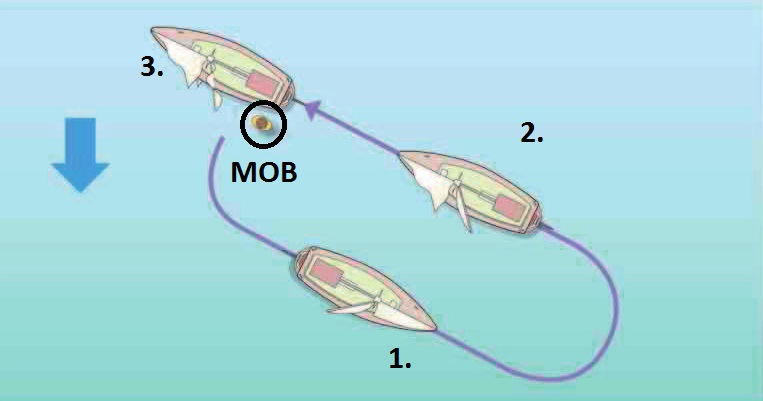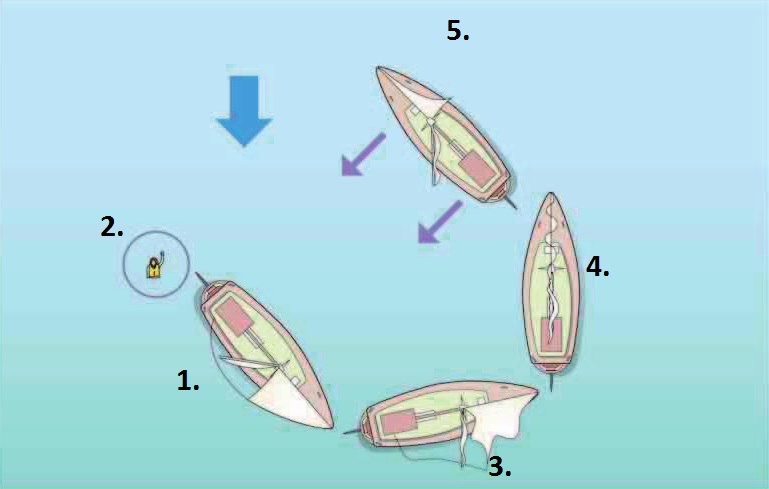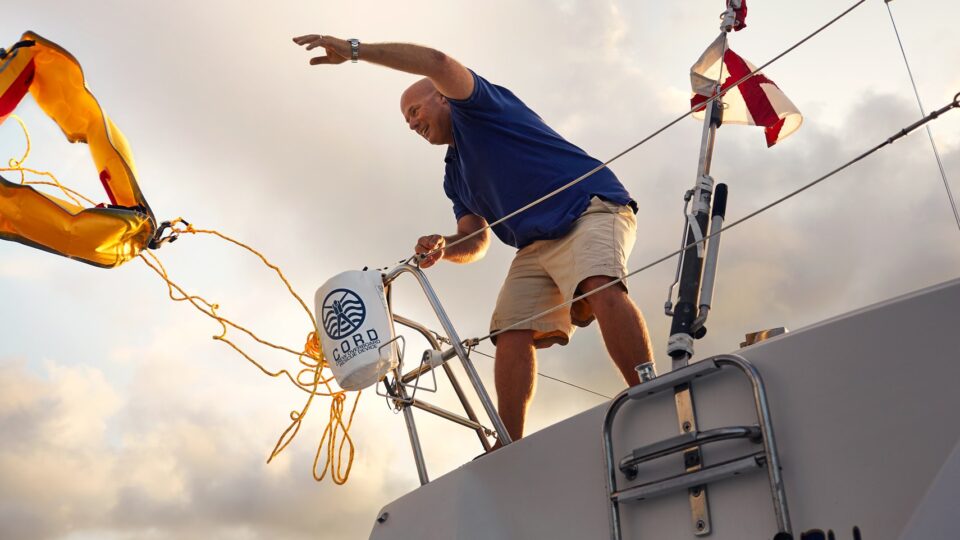Man Overboard Recovery Procedure
Having a man overboard (MOB) is one of the greatest fears of any skipper. If a person falls overboard, they are in grave danger. However, a prompt and efficient Man Overboard Recovery Procedure can prevent a fatality. The skipper should brief the crew on what to do in this situation and practice both the “sail away and return” and the “crash stop” drills.
What Immediate Actions To Take When You Have a Man Overboard
- Yell ‘man overboard’ to alert the crew and prepare them to take action.
- Press the Man Overboard button on the GPS.
- Throw a heaving line or, ideally, a lifebuoy and danbuoy (a floating pole with flag), as shown here, if you can stop the boat close to the man overboard.
- Keep the MOB in sight. If you are the skipper, delegate one person to keep a constant watch and point at the MOB throughout the recovery maneuver.
- Perform a recovery maneuver to get the boat within reach of the MOB. Practice the options regularly.
- Pull the MOB back to the boat if they are conscious and can reach the heaving line or lifebuoy. The danbuoy is easier to see than the lifebuoy from the water. It is also much easier to see from the boat than a head in the water.
How To Sail Away and Return

2. Tack and approach on a close reach.
3. Stop to windward of the MOB in calm sea.
- Sail Away and Return: When under sail, you can turn to a broad reach, sail away to get space to tack, and return.
- Approach: Head back to the MOB on a close reach and slow down by easing the sails. Stop to windward of the MOB if possible.
Performing a Crash Stop

2. MOB swims to the lifebuoy, if possible, and holds hand aloft to remain visible.
3. The boat turns rapidly towards the wind.
4. The boat is head-to-wind. It may not have sufficient momentum to tack but will stop fairly close to the MOB.
5. Boat has tacked and, with the jib still cleated on the old leeward side, it will heave-to and drift towards the MOB. Adjust sails and tiller to maneuver closer or start the engine.
- Crash Stop: Use full helm to turn towards the wind. Depending on the course, the boat will tack or stop head-to-wind.
- Use the Engine: Check that there are no ropes in the water, then start the engine to help you maneuver. Consider dropping the mainsail and furling the jib.
Practicing The Man Overboard (MOB) Procedure
It is very important to practice the man overboard (MOB) drill as often as possible. It is useful to have a quick practice at the start of a passage to remind the crew of the preferred techniques on your boat and the location of the lifebuoys and danbuoy. Use a weighted fender as a MOB and avoid giving the crew notice of when the practice is about to take place.
- Make sure all crew don life jackets as they will be working in an exposed situation.
- Call “Man overboard” to alert the crew. If the MOB is not connected by a harness line, instruct a crew member to point continuously at the MOB to keep him or her in sight.
- Deploy the lifebuoy and danbuoy if the MOB is close enough to reach it.
- Heave-to and stop the boat at once if possible.
- Complete your chosen maneuver (see pictures above) to bring the boat to windward of the MOB.
- When you are close enough, hold a boat hook or an oar for the MOB to grasp. You can also use the boat hook to hook the MOB’s life jacket or clothing to hold him or her alongside.
- In calm water, guide the MOB to the boarding ladder at the stern. In rough weather, this could be dangerous, with a risk that the MOB will be pushed under the stern.
- Make sure that the propeller is not turning when the MOB is near the stern. It is safest to stop the engine. In rough seas, recover the MOB from the side of the boat. It is usually easiest to do this from the leeward side, but it is not always possible. Use a halyard to hoist the MOB aboard.
- Be ready to help the MOB climb the ladder, which can be difficult in sodden waterproofs.
- As soon as the MOB is back on board, get him or her below, and assess if medical attention is required. Take action to prevent and treat hypothermia.
